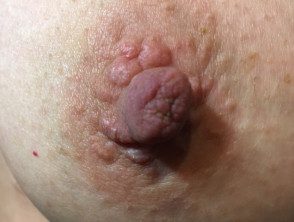What is the nipple? papillomatosis?
Papillomatosis of the nipple is characterized by benign growth of numerous papillomas arising from the lactiferous duct epithelium of the nipple Also known as flowery nipple papillomatosis, nipple adenomaand erosive adenomatosis
Papillomatosis of the nipple

Papillomatosis of the nipple
Who gets papillomatosis of the nipple?
Papillomatosis of the nipple is rare. It occurs mainly in women between the ages of 35 and 55, but can occur at any age. It occasionally affects men.
What are the clinical features of nipple papillomatosis and how is it diagnosed?
Papillomatosis of the nipple presents as a palpable mass or swelling on the surface of the nipple. It may be discovered incidentally during a breast exam.
Other clinical features include:
- erosions
- Download of serous or bloody fluid
- itching or tenderness
What are the complications of papillomatosis of the nipple?
Papillomatosis of the nipple is harmless. As for any fibrocystic changes within the breast tissue, associations with a slightly increased risk of breast Cancer compared to the general population, although this risk is still very low.
Syringomatous adenoma is a variant of papillomatosis of the nipple, distinguished by histology due to the absence of intraductal epithelial hyperplasia and oval, elongated ducts. Syringomatous adenoma tends to be infiltrative and locally invader.
How is papillomatosis of the nipple diagnosed?
A skin biopsy It may be performed to confirm the diagnosis of papillomatosis of the nipple.
Histologically, shows papillomatosis of the nipple proliferating ductal structures that extend into the sinus stroma, lined by a double layer of epithelium. Other histological Characteristics include the presence of curbfilled cysts and small snouts of apical cells.
Breast x-ray, mammogram, or ultrasound an examination may be performed to exclude an underlying tumor.
Which is the differential diagnosis for papillomatosis of the nipple?
The differential diagnosis for papillomatosis of the nipple includes:
- Tubular and lactating adenomas (benign growths of epithelial cells of the mammary glands)
-
Nipple eczema, often due to atopic eczema, which can cause exudation, crust and climbing
- Paget's disease of the breast
- Hyperkeratosis of the nipple and areola.
What is the treatment for papillomatosis of the nipple?
When practical, papillomatosis of the nipple is treated completely excision of the injury. This is a minor procedure usually performed under local anesthetic. If the entire affected area is not removed, the affected area should be checked from time to time, especially if the appearance changes.

